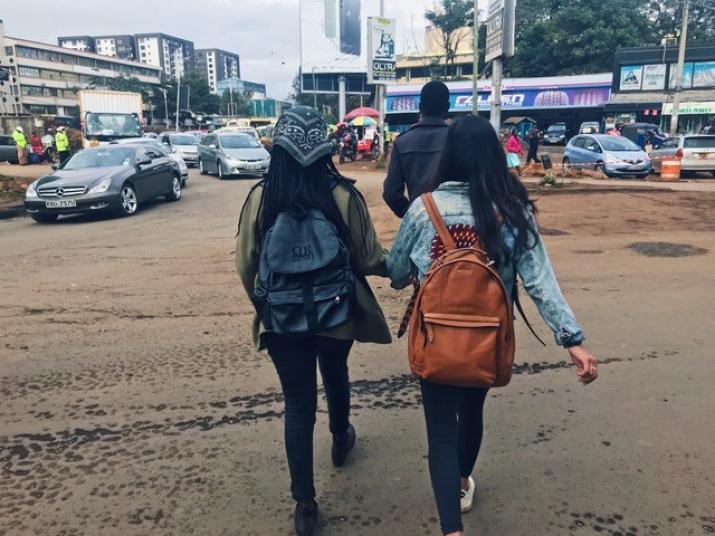
My research partner and fellow Duke student, Phoebe Kiburi, and I navigate the streets of Nairobi as we promote the use of the askNivi online platform.
Published July 9, 2018 under Voices of DGHI
By Stephanie Jaffe, rising junior global health and public policy major
“At that speed there’s no excuse” was the motto today as my research partner, Phoebe, and I speed-walked through Nairobi’s Central Business District (CBD). This phrase was a reference to the cars heading towards us as we crossed street after busy street in our mission across town. Traffic laws in Nairobi are more like suggestions, so we had decided that we might as well cross the road if the cars were going slow enough because if they hit us, they’d have no excuse.
Today was a lesson in navigating both the busy streets of the CBD and the administrations of Nairobi universities, and while we refused to assume fault when facing down the city’s reckless drivers, the mistakes made today were all our own.
Over the past few weeks, Phoebe and I have been working on developing a Campus Ambassador program to try to introduce a product called askNivi to university-aged women. askNivi is an online platform that enables people to text for free to ask questions and get answers and resources about reproductive health and contraception.
However, with projects like these, the transition from idea to execution is often the most challenging, and surely the most daunting. Our goal today was to convince the Dean of Students at two universities, the University of Nairobi and the Technical University of Kenya, to grant us permission to operate on their campus.
We had a rocky start when I realized, right before leaving for the city, that we had no handouts to give the people we were talking to. Although I had emailed the deans, we had not received responses from either of them, and I realized that the script I had prepared would probably not be sufficient for a busy university administrator. I hastily put together a description of our company and printed it, and we boarded a matatu, or taxi bus, to the city.
The first school we visited, the University of Nairobi, is the biggest in Kenya. We walked into the office of the Dean of Students, where we found a secretary who remembered my email but didn’t know when the dean would be back and didn’t know when he’d be free for a meeting. We gave her our phone numbers and left, realizing once we were well on our way to the Technical University of Kenya (“Tech”) that we should have left one of the handouts I’d created. Oops.
After trekking across town, ascending six flights of stairs, and asking at least four people for directions, we reached the office of the Dean of Students at Tech. Unsurprisingly, the dean was not in his office, and we spent a long time chatting with a secretary about whom we should talk to about our proposal.
She directed us to another office, where, after giving our entire presentation and handing the administrator our description page, she told us that we needed to give the dean our proposal in writing.
I realized then that we had made yet another mistake. Of course we should have included our program proposal along with our company description—but, I figured, it wasn’t too late.
After some searching, we found a coffee shop with spotty WiFi and set about putting together this document. After hasty input from our supervisors and a slightly panicked conference call, we managed to produce a PDF, signed by Nivi’s CEO, before my computer died.
We were looking for a computer center where we could print colored copies to give to the universities when I got a call from the secretary at the University of Nairobi, who patched me through to the Dean.
His immediate response was that they already had too many programs. I tried to explain to him that our program would require no effort on the university’s part. He sternly replied that he didn’t know what our program was, what we were asking for, and who we were. They were fair points: he wouldn’t know any of these things, because we hadn’t yet given him information about our proposal. I asked if we could drop off a description of our company and our proposed program, and he agreed.
At that point, we realized that we should not have gone to the biggest, most important university for our first visit. It would have been smarter to go to a smaller university first to test out our strategy and see what worked or didn’t work. However, what was done was done.
After hours of fumbling around the city trying to rectify mistake after mistake, we set off once again for Tech, climbed the six flights of stairs, and dropped off our handout. Then we speed-walked back across the city and did the same at the University of Nairobi.
We ended the day having spent about eight hours in the CBD. We talked to zero deans, got zero permissions, and may have hurt our cause more than we helped it due to our lack of foresight and understanding of Kenyan university administration.
However, we both acknowledged that this was a learning experience for us, and that we truly did our best given the circumstances and our limited experience. When we go to the University of Jomo Kenyatta tomorrow, we will have a clear, concise document outlining our proposal and the expectation that we may still need to improvise when we get there. So, although today was disappointing, I’m hopeful that if we keep trying, we will break through to one of these universities and get someone to hear us out.
And we didn’t get hit by any cars ... so, small victories.


